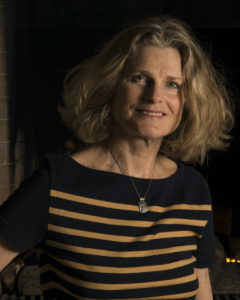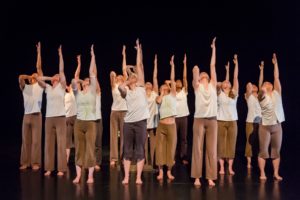Emotion and Intellect: What Graham and Cunningham techniques offer today - Vancouver Ballet Society
- Home
- Features 2020 - 2023
- Emotion and Intellect: What Graham and Cunningham techniques offer today

By Rebecca Karpus
Sunlight spills through the window and into the white studio. The live accompaniment is quiet, yet intense. As the piano improvisation builds, one dancer slowly begins to move through the space. She walks among the group and then intentionally brushes past another dancer, as a cue to join. Intuitively, the cycle continues, until all 20 bodies are confidently weaving between each other like a carefully calculated ritual. There is a beautiful paradox within the Cunningham-inspired exercise — it is intricate and enticing, and yet, “the instructions are simple,” explains Simon Fraser University’s Megan Walker-Straight, who is teaching the class at the university’s downtown Vancouver campus.

SFU’s dance degree program places equal emphasis on many modern dance influences, including early styles such as Cunningham and Graham techniques. But how relevant are these historical techniques today?
Twentieth-century American dancer and choreographer Martha Graham created her own dance technique, based on modernist notions such as emotional individuality and expressionism, supported by the use of narrative and the marriage of music and movement. Her technique was originally developed to offer a vocabulary within her choreography, which often followed powerful plot lines based on Greek myths.
Although Graham classes still embrace the main principles, such as the foundational concepts of contraction, release and spiral which are often emphasized in the upper body, SFU associate professor Judith Garay believes the technique is still evolving and always has. With 10 years of experience dancing in the Martha Graham Dance Company in New York City (mainly during the 1980’s, while Graham herself was at the helm), Garay is intimately familiar with the multiple eras of Graham’s choreographic evolution. This evolution resulted in a very different look, for example, between the dark and expressive Lamentation of 1930 and the more realistic and physically linear Appalachian Spring of 1944. In 1981, Acts of Light was even referred to as “neoclassical” by New York Times dance critic Anne Kisselgoff, and featured a 19th-century score, also a departure from Graham’s earlier work. Throughout her career, Garay has worked with many Graham company dancers and can recognize the differences in style and perspective between the various eras in which they performed.
While Graham passed in 1991, Garay insists the technique is very much alive. Most dancers today train in many styles, including ballet, which allows more mobility and extension when they do Graham movement than was typical of dedicated Graham-only dancers of the past.
Garay has been teaching Graham classes at SFU for almost 30 years and considers the technique to be as valuable as ballet or any other modern or contemporary style for a dancer’s skillset. She says that Graham technique can teach dancers to use the torso extremely specifically and “in a way that can convey emotional content.” For ballet dancers who predominantly develop articulation in their limbs, Graham is especially helpful, as the technique can expand their movement vocabulary in other parts of their bodies, including the torso. Because of the technique’s emotionality, she says it also “teaches dancers to move from the inside out.”
Merce Cunningham was a pupil of Graham and, as many pupils do, chose to rebel against his teacher’s philosophies, creating his own postmodern dance technique. Separating movement from storyline or theme, traditional sense of musicality and explicit emotion, Cunningham believed freedom was found within the physical movement itself.

“I can see it the way I need to see it,” Walker-Straight remembers thinking while first watching the Merce Cunningham Dance Company perform when she was a dance student at University of California, Berkeley. Walker-Straight went on to dance with the company for several years and experienced Cunningham’s unorthodox choreographic process, such as not hearing the score until the premiere and generating movement from chance operations. These involved tasks, such as rolling dice, to determine speed, spacing and so forth. Like Graham technique, Cunningham technique was created to assist in its founder’s choreography, and also maintained its core concepts despite much choreographic evolution over the years.
Walker-Straight says that while Cunningham’s choreography is intellectual in essence, she was able to find her own sense of expression within the lack of traditional dance elements. She appreciates that Cunningham did not want himself or his dancers to be confined by the usual components of Western concert dance, and this sense of uninhibited exploration is evident in the way Walker-Straight introduces musicality today, pushing students not to dance on the counts, but to “play around the edges of them.”
After almost 20 years at SFU, Walker-Straight acknowledges that she continues to learn while teaching, as Cunningham technique is so complex. Because of the unusual way material is sometimes generated, the movement can be “extreme and awkward,” which can be a unique and valuable tool for today’s dancers. The inorganic patterns and rhythms, she says, push dancers to be present and alert, allowing unexpected movement choices and directional shifts.
Walker-Straight notes there is a place and time for all styles of movement. For example, the counterintuitive positions and shapes in Cunningham could create problems in a contact improvisation class, but help in building inventive movement during a creative process, especially for emerging choreographers. It is no wonder, she says, that so many of Cunningham’s pupils have gone on to choreograph their own work.
The long-established Graham and Cunningham techniques, with their ties to seminal American choreographers and their work, provide dancers in a university setting a sense of embodiment and context that complements their dance history courses. Both techniques are relayed with a form of deep learning that has endured the test of time and is passed on physically and intellectually from careful lineage. Moreover, the techniques provide a historical grounding that can inform their experience of watching or creating choreography, helping young artists understand what is truly “new” or what is in fact simply a version of a pre-existing concept.
Although the two techniques often contrast one another, they run parallel in impact. “Cunningham is so intellectual and Graham is so emotional,” Garay says. “Very few people are in love with both techniques, but very few don’t appreciate the one that is their opposite as a way of learning and a way of challenging themselves to grow as an artist.”

